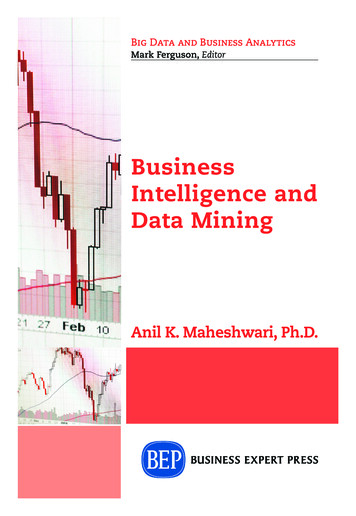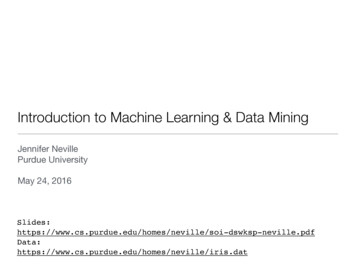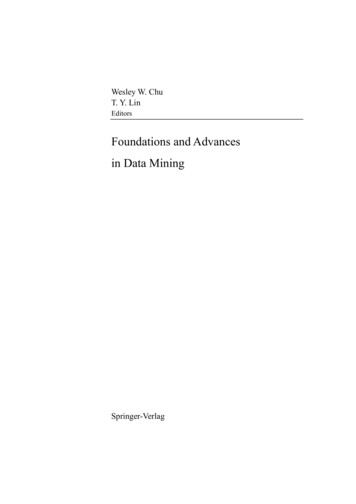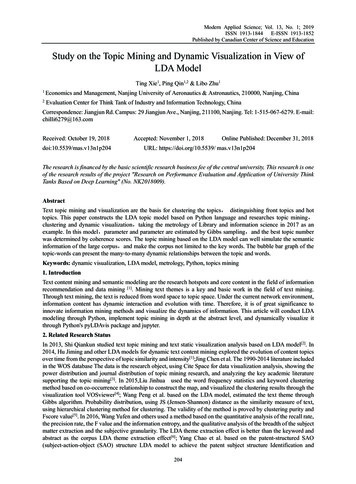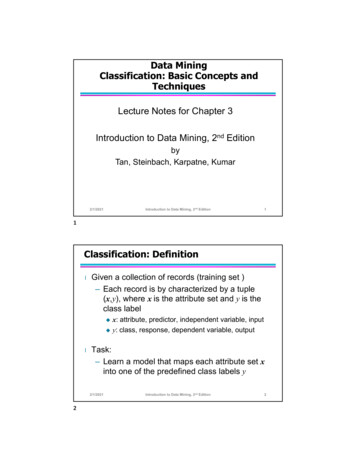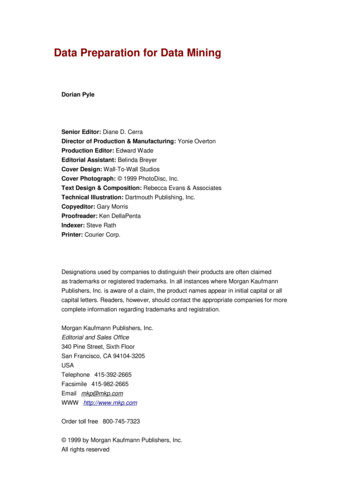
Transcription
Data Preparation for Data MiningDorian PyleSenior Editor: Diane D. CerraDirector of Production & Manufacturing: Yonie OvertonProduction Editor: Edward WadeEditorial Assistant: Belinda BreyerCover Design: Wall-To-Wall StudiosCover Photograph: 1999 PhotoDisc, Inc.Text Design & Composition: Rebecca Evans & AssociatesTechnical Illustration: Dartmouth Publishing, Inc.Copyeditor: Gary MorrisProofreader: Ken DellaPentaIndexer: Steve RathPrinter: Courier Corp.Designations used by companies to distinguish their products are often claimedas trademarks or registered trademarks. In all instances where Morgan KaufmannPublishers, Inc. is aware of a claim, the product names appear in initial capital or allcapital letters. Readers, however, should contact the appropriate companies for morecomplete information regarding trademarks and registration.Morgan Kaufmann Publishers, Inc.Editorial and Sales Office340 Pine Street, Sixth FloorSan Francisco, CA 94104-3205USATelephone 415-392-2665Facsimile 415-982-2665Email mkp@mkp.comWWW http://www.mkp.comOrder toll free 800-745-7323 1999 by Morgan Kaufmann Publishers, Inc.All rights reserved
No part of this publication may be reproduced, stored in a retrieval system, or transmittedin any form or by any means—electronic, mechanical, photocopying, orotherwise—without the prior written permission of the publisher.DedicationTo my dearly beloved Pat, without whose love, encouragement, and support, this book, andvery much more, would never have come to be
Table of ContentsData Preparation for Data MiningPrefaceIntroductionChapter 1 - Data Exploration as a ProcessChapter 2 - The Nature of the World and Its Impact on Data PreparationChapter 3 - Data Preparation as a ProcessChapter 4 - Getting the Data—Basic PreparationChapter 5 - Sampling, Variability, and ConfidenceChapter 6 - Handling Nonnumerical VariablesChapter 7 - Normalizing and Redistributing VariablesChapter 8 - Replacing Missing and Empty ValuesChapter 9 - Series VariablesChapter 10 - Preparing the Data SetChapter 11 - The Data SurveyChapter 12 - Using Prepared DataAppendix A - Using the Demonstration Code on the CD-ROMAppendix B - Further Reading
PrefaceWhat This Book Is AboutThis book is about what to do with data to get the most out of it. There is a lot more to thatstatement than first meets the eye.Much information is available today about data warehouses, data mining, KDD, OLTP,OLAP, and a whole alphabet soup of other acronyms that describe techniques andmethods of storing, accessing, visualizing, and using data. There are books andmagazines about building models for making predictions of all types—fraud, marketing,new customers, consumer demand, economic statistics, stock movement, option prices,weather, sociological behavior, traffic demand, resource needs, and many more.In order to use the techniques, or make the predictions, industry professionals almostuniversally agree that one of the most important parts of any such project, and one of themost time-consuming and difficult, is data preparation. Unfortunately, data preparationhas been much like the weather—as the old aphorism has it, “Everyone talks about it, butno one does anything about it.” This book takes a detailed look at the problems inpreparing data, the solutions, and how to use the solutions to get the most out of thedata—whatever you want to use it for. This book tells you what can be done about it,exactly how it can be done, and what it achieves, and puts a powerful kit of tools directly inyour hands that allows you to do it.How important is adequate data preparation? After finding the right problem to solve, datapreparation is often the key to solving the problem. It can easily be the difference betweensuccess and failure, between useable insights and incomprehensible murk, betweenworthwhile predictions and useless guesses.For instance, in one case data carefully prepared for warehousing proved useless formodeling. The preparation for warehousing had destroyed the useable information contentfor the needed mining project. Preparing the data for mining, rather than warehousing,produced a 550% improvement in model accuracy. In another case, a commercial bakerachieved a bottom-line improvement approaching 1 million by using data prepared with thetechniques described in this book instead of previous approaches.Who This Book Is ForThis book is written primarily for the computer savvy analyst or modeler who works withdata on a daily basis and who wants to use data mining to get the most out of data. Thetype of data the analyst works with is not important. It may be financial, marketing,business, stock trading, telecommunications, healthcare, medical, epidemiological,
genomic, chemical, process, meteorological, marine, aviation, physical, credit, insurance,retail, or any type of data requiring analysis. What is important is that the analyst needs toget the most information out of the data.At a second level, this book is also intended for anyone who needs to understand the issuesin data preparation, even if they are not directly involved in preparing or working with data.Reading this book will give anyone who uses analyses provided from an analyst’s work amuch better understanding of the results and limitations that the analyst works with, and a fardeeper insight into what the analyses mean, where they can be used, and what can bereasonably expected from any analysis.Why I Wrote ItThere are many good books available today that discuss how to collect data, particularlyin government and business. Simply look for titles about databases and datawarehousing. There are many equally good books about data mining that discuss toolsand algorithms. But few, if any books, address what to do with the “dirty data” after it iscollected and before exploring it with a data mining tool. Yet this part of the process iscritical.I wrote this book to address that gap in the process between identifying data and buildingmodels. It will take you from the point where data has been identified in some form orother, if not assembled. It will walk you through the process of identifying an appropriateproblem, relating the data back to the world from which it was collected, assembling thedata into mineable form, discovering problems with the data, fixing the problems, anddiscovering what is in the data—that is, whether continuing with mining will deliver whatyou need. It walks you through the whole process, starting with data discovery, anddeposits you on the very doorstep of building a data-mined model.This is not an easy journey, but it is one that I have trodden many times in many projects.There is a “beaten path,” and my express purpose in writing this book is to show exactlywhere the path leads, why it goes where it does, and to provide tools and a map so that youcan tread it again on your own when you need to.Special FeaturesA CD-ROM accompanies the book. Preparing data requires manipulating it and looking atit in various ways. All of the actual data manipulation techniques that are conceptuallydescribed in the book, mainly in Chapters 5 through 8 and 10, are illustrated by Cprograms. For ease of understanding, each technique is illustrated, so far as possible, in aseparate, well-commented C source file. If compiled as an integrated whole, theseprovide an automated data preparation tool.The CD-ROM also includes demonstration versions of other tools mentioned, and useful
for preparing data, including WizWhy and WizRule from WizSoft, KnowledgeSEEKERfrom Angoss, and Statistica from StatSoft.Throughout the book, several data sets illustrate the topics covered. They are included onthe CD-ROM for reader investigation.AcknowledgmentsI am indebted beyond measure to my dearly beloved wife, Pat Thompson, for her devotedhelp, support, and encouragement while this book was in progress. Her reading andrereading of the manuscript helped me to clarify many difficult points. There are manypoints that would without doubt be far less clear but for her help. I am also indebted to myfriend Dr. Ralphe Wiggins who read the manuscript and helped me clarify a number ofpoints and improve the overall organization of chapters.My publisher helped me greatly by having the book reviewed by several anonymousreviewers, all of whom helped improve the final book. To those I can only generallyexpress my thanks. However, one reviewer, Karen Watterson, was extremely helpful, andat times challenging, for which I was then, and remain, most grateful.My gratitude also goes to Irene Sered of WizSoft, Ken Ono of Angoss, and Robert Eamesof StatSoft, all of whom supported the project as it went forward, providing thedemonstration software.Last, but certainly not least, my gratitude goes to Diane Cerra, my editor at MorganKaufmann, to Edward Wade the production editor, to the copyeditor and proofreader whoso carefully read the manuscript and made improvements, to the illustrators whoimproved my attempts at the figures throughout, and to all of the staff at MorganKaufmann who helped bring this project to completion.In spite of all the help, support, encouragement, and constructive criticism offered by theseand other people, I alone, of course, remain responsible for the book’s shortcomings, faults,and failings.
IntroductionEver since the Sumerian and Elam peoples living in the Tigris and Euphrates River basinsome 5500 years ago invented data collection using dried mud tablets marked with taxrecords, people have been trying to understand the meaning of, and get use from,collected data. More directly, they have been trying to determine how to use theinformation in that data to improve their lives and achieve their objectives.These are the same objectives addressed by the latest technology to wring use andmeaning out of data—the group of technologies that today have come to be called datamining. Often, something important gets lost in the rush to apply these powerfultechnologies to “find something in this data.” The technologies themselves are not ananswer. They are tools to help find an answer. It is no use looking for an answer unlessthere is a question. But equally important, given a question, both the data and the minerneed to be readied to find the best answer to the question asked.This book has two objectives: 1) to present a proven approach to preparing the data, andthe miner, to get the most out of computer-stored data, and 2) to help analysts andbusiness managers make cost-effective and informed decisions based on the data, theirexpertise, and business needs and constraints. This book is intended for everyone whoworks with or uses data and who needs to understand the nature, limitations, application,and use of the results they get.In The Wizard of Oz, while the wizard hid behind the curtain and manipulated the controls,the results were both amazing and magical. When the curtain was pulled back, and thewizard could be seen manipulating the controls, the results were still amazing—thecowardly lion did find courage, the tin man his heart, the scarecrow his brain. The powerremained; only the mystery evaporated. This book “pulls back the curtain” about thereason, application, applicability, use, and results of data preparation.Knowledge, Power, Data, and the WorldFrancis Bacon said, “Knowledge is power.” But is it? And if it is, where is the power inknowledge?Power is the ability to control, or at least influence, events. Control implies taking anaction that produces a known result. So the power in knowledge is in knowing what to doto get what you want—knowing which actions produce which results, and how and whento take them. Knowledge, then, is having a collection of actions that work reliably. Butwhere does this knowledge come from?Our knowledge of the world is a map of how things affect each other. This comes from
observation—watching what happens. Watching implies making a record of happenings,either mental or in some other form. These records, when in nonmental form, are data,which is simply a collection of observations of things that happen, and what other thingshappen when the first things happen. And how consistently.The world forms a comprehensive interlocking system, called by philosophers “the greatsystem of the world.” Essentially, when any particular thing happens in the world, otherthings happen too. We call this causality and want to know what causes what. Everythingaffects everything else. As the colloquial expression has it, “You can’t do just one thing.” Thissystem of connected happenings, or events, is reflected in the data collected.Data, Fishing, and Decision MakingWe are today awash in data, primarily collected by governments and businesses.Automation produces an ever-growing flood of data, now feeding such a vast ocean thatwe can only watch the swelling tide, amazed. Dazed by our apparent inability to come togrips with the knowledge swimming in the vast ocean before us, we know there must be avast harvest to be had in this ocean, if only we could find the means.Fishing in data has traditionally been the realm of statistical analysis. But statisticalanalysis has been as a boy fishing with a pole from a riverbank. Today’s businessmanagers need more powerful and effective means to reap the harvest—ways to exploreand identify the denizens of the ocean, and to bring the harvest home. Today there arethree such tools for harvesting: data modeling reveals each “fish,” data surveying looks atthe shape of the ocean and is the “fish finder,” and data preparation clears the water andremoves the murk so that the “fish” are clearly seen and easily attracted.So much for metaphor. In truth, corporations have huge data “lakes” that range fromcomprehensive data stores to data warehouses, data marts, and even data “garbagedumps.” Some of these are more useful than others, but in every case they were created,and data collected, because of the underlying assumption that collected data has value,corporate value—that is it can be turned into money.All corporations have to make decisions about which actions are best to achieve thecorporate interest. Informed decisions—those made with knowledge of currentcircumstances and likely outcome—are more effective than uninformed decisions. The corebusiness of any corporate entity is making appropriate decisions, and enterprise decisionsupport is the core strategic process, fed by knowledge and expertise—and by the bestavailable information. Much of the needed information is simply waiting to be discovered,submerged in collected data.Mining Data for InformationThe most recently developed tools for exploring data, today known as data mining tools,
only begin the process of automating the search. To date, most modern data mining toolshave focused almost exclusively on building models—identifying the “fish.” Yet enormousdividends come from applying the modeling tools to correctly prepared data. Butpreparing data for modeling has been an extremely time-consuming process, traditionallycarried out by hand and very hard to automate.This book describes automated techniques of data preparation, both methods andbusiness benefits. These proven automated techniques can cut the preparation time byup to 90%, depending on the quality of the original data, so the modeler produces bettermodels in less time. As powerful and effective as these techniques are, the key benefit isthat, properly applied, the data preparation process prepares both the data and themodeler. When data is properly prepared, the miner unavoidably gains understanding andinsight into the content, range of applicability, and limits to use of the data. When data iscorrectly prepared and surveyed, the quality of the models produced will depend mostlyon the content of the data, not so much on the ability of the modeler.But often today, instead of adequate data preparation and accurate data survey,time-consuming models are built and rebuilt in an effort to understand data. Modeling andremodeling are not the most cost-efficient or the most effective way to discover what isenfolded in a data set. If a model is needed, the data survey shows exactly which model (ormodels if several best fit the need) is appropriate, how to build it, how well it will work, whereit can be applied, and how reliable it will be and its limits to performance. All this can be donebefore any model is built, and in a small fraction of the time it takes to explore data bymodeling.Preparing the Data, Preparing the MinerCorrect data preparation prepares both the miner and the data. Preparing the data meansthe model is built right. Preparing the miner means the right model is built. Datapreparation and the data survey lead to an understanding of the data that allows the rightmodel to be built, and built right the first time. But it may well be that in any case, thepreparation and survey lead the miner to an understanding of the information enfolded inthe data, and perhaps that is all that is wanted. But who is the miner?Exploring data has traditionally been a specialist activity. But it is business managers whoneed the results, insights, and intuitions embedded in stored data. As recently as 20 yearsago, spreadsheets were regarded as specialized tools used by accountants and wereconsidered to have little applicability to general business management. Today the vastmajority of business managers regard the spreadsheet as an indispensable tool. As withthe spreadsheet, so too the time is fast approaching when business managers will directlyaccess and use data exploration tools in their daily business decision making. Manyimportant business processes will be run by automated systems, with business managersand analysts monitoring, guiding, and driving the processes from “control panels.” Suchstructures are already beginning to be deployed. Skilled data modelers and explorers will
be needed to construct and maintain these systems and deploy them into production.So who is the miner? Anyone who needs to understand and use what is in corporate datasets. This includes, but is not limited to, business managers, business analysts, consultants,data analysts, marketing managers, finance managers, personnel managers, corporateexecutives, and statisticians. The miner in this book refers to anyone who needs to directlyunderstand data and wants to apply the techniques to get the best understanding out of thedata as effectively as possible. (The miner may or may not be a specialist who implementsthese techniques for preparation. It is at least someone who needs to use them tounderstand what is going on and why.) The modeler refers to someone versed in the specialtechniques and methodologies of constructing models.Is This Book for You?I have been involved, one way or another, in the world of using automated techniques toextract “meaning” from data for over a quarter of a century. Recently, the term “datamining” has become fashionable. It is an old term that has changed slightly in meaningand gained a newfound respectability. It used to be used with the connotation that if youmess around in data long enough, you are sure to find something that seems useful, but isprobably just an exercise in self-deception. (And there is a warning to be had there,because self-deception is very easy!)This “mining” of data used to be the specialist province of trained analysts andstatisticians. The techniques were mainly manual, data quantities small, and thetechniques complex. The miracle of the modern computer (not said tongue in cheek) haschanged the entire nature of data exploration. The rate of generation and collection of rawdata has grown so rapid that it is absolutely beyond the means of human endeavor tokeep up. And yet there is not only meaning, but huge value to be had from understandingwhat is in the data collections. Some of this meaning is for business—where to find newcustomers, stop fraud, improve production, reduce costs. But other data containsmeaning that is important to understand, for our lives depend on knowing some of it! Isglobal warming real or not? Will massive storms continue to wreak more and more havocwith our technological civilization? Is a new ice age almost upon us? Is a depressionimminent? Will we run out of resources? How can the developing world be best helped?Can we prevent the spread of AIDS? What is the meaning of the human genome?This book will not answer any of those questions, but they, along with a host of otherquestions large and small, will be explored, and explored almost certainly by automatedmeans—that is, those techniques today called data mining. But the explorers will not beexclusively drawn from a few, highly trained professionals. Professional skill will be sorelyneeded, but the bulk of the exploration to come will be done by the people who face theproblems, and they may well not have access to skilled explorers. What they will have isaccess to high-powered, almost fully automated exploration tools. They will need to knowthe appropriate use and limits of the tools—and how to best prepare their data.
If you are looking at this book, and if you have read this far through the introduction, almostcertainly this book is for you! It is you who are the “they” who will be doing the exploring, andthis book will help you.OrganizationData preparation is both a broad and a narrow topic. Business managers want anoverview of where data preparation fits and what it delivers. Data miners and modelersneed to know which tools and techniques can be applied to data, and how to apply themto bring the benefits promised. Business and data analysts want to know how to use thetechniques and their limits to usefulness. All of these agendas can be met, although eachagenda may require a different path through the book.Chapters 1 through 3 lay the ground work by describing the data exploration process inwhich data preparation takes place. Chapters 4 through 10 outline each of the problemsthat have to be addressed in best exposing the information content enfolded in data, andprovide conceptual explanations of how to deal with each problem. Chapters 11 and 12look at what can be discovered from prepared data, and how both miner and modelingperformance are improved by using the techniques described.Chapter 1 places data preparation in perspective as part of a decision-making process. Itdiscusses how to find appropriate problems and how to define what a solution looks like.Without a clear idea of the business problem, the proposed business objectives, andenough knowledge of the data to determine if it’s an appropriate place to look for at leastpart of the answer, preparing data is for naught. While Chapter 1 provides a top-downperspective, Chapter 2 tackles the process from the bottom up, tying data to the realworld, and explaining the inherent limitations and problems in trying to capture data aboutthe world. Since data is the primary foundation, the chapter looks at what data is as itexists in database structures. Chapter 3 describes the data exploration process and theinterrelationship between its components—data preparation, data survey, and datamodeling. The focus in this chapter is on how the pieces link together and interact witheach other.Chapters 4 through 9 describe how to actually prepare data for survey and modeling.These chapters introduce the problems that need to be solved and provide conceptualdescriptions of all of the techniques to deal with the problems. Chapter 4 discusses thedata assay, the part of the process that looks at assembling data into a mineable form.There may be much more to this than simply using an extract from a warehouse! Theassay also reveals much information about the form, structure, and utility of a data set.Chapters 5 through 8 discuss a range of problems that afflict data, their solutions, andalso the concept of how to effectively expose information content. Among the topics thesechapters address are discovering how much data is needed; appropriately numeratingalpha values; removing variables and data; appropriately replacing missing values;
normalizing range and distribution; and assembling, enhancing, enriching, compressing,and reducing data and data sets. Some parts of these topics are inherently andunavoidably mathematical. In every case, the mathematics needed to understand thetechniques is at the “forgotten high school math” level. Wherever possible, and where it isnot required for a conceptual understanding of the issues, any mathematics is containedin a section titled Supplemental Material at the end of those particular chapters. Chapter 9deals entirely with preparing series data, such as time series.Chapter 10 looks at issues concerning the data set as a whole that remain after dealingwith problems that exist with variables. These issues concern restructuring data andensuring that the final data set actually meets the need of the business problem.Chapter 11 takes a brief look at some of the techniques required for surveying data andexamines a small part of the survey of the example data set included on theaccompanying CD-ROM. This brief look illustrates where the survey fits and the highvalue it returns. Chapter 12 looks at using prepared data in modeling and demonstratesthe impact that the techniques discussed in earlier chapters have on data.All of the preparation techniques discussed here are illustrated in a suite of C routines on theaccompanying CD-ROM. Taken together they demonstrate automated data preparation andcompile to provide a demonstration data preparation program illustrating all of the pointsdiscussed. All of the code was written to make the principles at work as clear as possible,rather than optimizing for speed, computational efficiency, or any other metric. Example datasets for preparation and modeling are included. These are the data sets used to illustrate thediscussed examples. They are based on, or extracted from, actually modeled data sets. Thedata in each set is assembled into a table, but is not otherwise prepared. Use the tools andtechniques described in the book to explore this data. Many of the specific problems in thesedata sets are discussed, but by no means all. There are surprises lurking, some of whichneed active involvement by the miner or modeler, and which cannot all be automaticallycorrected.Back to the FutureI have been involved in the field known today as data mining, including data preparation,data surveying, and data modeling, for more than 25 years. However, this is afast-developing field, and automated data preparation is not a finished science by anymeans. New developments come only from addressing new problems or improving thetechniques used in solving existing problems. The author welcomes contact from anyonewho has an interest in the practical application of data exploration techniques in solvingbusiness problems.The techniques in this book were developed over many years in response to data problemsand modeling difficulties. But, of course, no problems are solved in a vacuum. I am indebtedto colleagues who unstintingly gave of their time, advice, and insight in bringing this book to
fruition. I am equally indebted to the authors of many books who shared their knowledge andinsight by writing their own books. Sir Isaac Newton expressed the thought that if he hadseen further than others, it was because he stood on the shoulders of giants. The giants onwhose shoulders I, and all data explorers stand, are those who thought deeply about theproblems of data and its representations of the world, and who wrote and spoke of theirconclusions.
Chapter 1: Data Exploration as a ProcessOverviewData exploration starts with data, right? Wrong! That is about as true as saying thatmaking sales starts with products.Making sales starts with identifying a need in the marketplace that you know how to meetprofitably. The product must fit the need. If the product fits the need, is affordable to theend consumer, and the consumer is informed of your product’s availability (marketing),then, and only then, can sales be made. When making sales, meeting the needs of themarketplace is paramount.Data exploration also starts with identifying a need in its “marketplace” that can be metprofitably. Its marketplace is corporate decision making. If a company cannot makecorrect and appropriate decisions about marketing strategies, resource deployment,product distribution, and every other area of corporate behavior, it is ultimately doomed.Making correct, appropriate, and informed business decisions is the paramount businessneed. Data exploration can provide some of the basic source material for decisionmaking—information. It is information alone that allows informed decision making.So if the marketplace for data exploration is corporate decision making, what about profit?How can providing any information not be profitable to the company? To a degree, anyinformation is profitable, but not all information is equally useful. It is more valuable toprovide accurate, timely, and useful information addressing corporate strategic problemsthan about a small problem the company doesn’t care about and won’t deploy resourcesto fix anyway. So the value of the information is always proportional to the scale of theproblem it addresses. And it always costs to discover information. Always. It takes time,money, personnel, effort, skills, and insight to discover appropriate information. If the costof discovery is greater than the value gained, the effort is not profitable.What, then, of marketing the discovered information? Surely it doesn’t need marketing.Corporate decision makers know what they need to know and will ask for it—won’t they?The short answer is no! Just as you wouldn’t even go to look for stereo equipment unlessyou knew it existed, and what it was good for, so decision makers won’t seek informationunless they know it can be had and what it is good for. Consumer audio has a great depthof detail t
This book is written primarily for the computer savvy analyst or modeler who works with data on a daily basis and who wants to use data mining to get the most out of data. The type of data the analyst works with is not important. It may be financial, marketing, business, stock trading,



